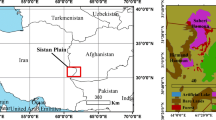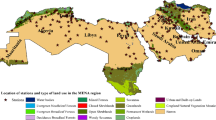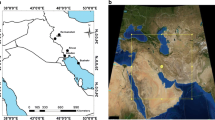Abstract
The Middle East frontal sand and dust storms (SDS) occur in non-summer seasons, and represent an important phenomenon of this region’s climate. Among the mentioned type, spring SDS are the most common. Trend analysis was used in the current study to investigate the spatial-temporal variability of springtime dust events in the Middle East using synoptic station observation from 2011 to 2022. The plausible changes in some controlling factors of dust activity at selected important dust sources in the Middle East were also studied during this time period. Our results showed a statistically significant spike in springtime dust events across the Middle East, particularly in May 2022. To evaluate the relative importance of controlling factors, the applied feature of importance analysis using random forest (RF) showed the higher relative importance of topsoil layer wetness, surface soil temperature, and surface wind speed in dust activity over the Middle East between 2011 and 2022. Long-term trend analysis of topsoil moisture and temperature, using the Mann-Kendall trend test, showed a decrease in soil moisture and an increase in soil temperature in some selected important dust sources in the Middle East. Moreover, our predictions using ARIMA models showed a high tendency to dust activities in selected major dust origins (domain 2 and domain 5) with a statistically significant increase (p-value < 0.05) between 2023 and 2029. Observed spatial and temporal changes within SDS hotspots can act as the first step to build up for the first time an SDS precise intensity scale, as well as establishing an SDS early warning system in future.









Similar content being viewed by others
Data availability
Data is available on request from the authors.
References
Al-Dousari A, Omar A, Al-Hemoud A, Aba A, Alrashedi M, Alrawi M et al (2022) A success story in controlling sand and dust storms hotspots in the middle east. Atmosphere 13:8. https://doi.org/10.3390/atmos13081335
Al-Dousari AM, Ibrahim MI, Al-Dousari N, Ahmed M, Al-Awadhi S (2018) Pollen in aeolian dust with relation to allergy and asthma in Kuwait. Aerobiologia 34:325–336. https://doi.org/10.1007/s10453-018-9516-8
Al-Hemoud A, Al-Dousari A, Misak R, Al-Sudairawi M, Naseeb A, Al-Dashti H, Al-Dousari N (2019) Economic impact and risk assessment of sand and dust storms (SDS) on the oil and gas industry in Kuwait. Sustainability 11:1–19. https://doi.org/10.3390/su11010200
Alshammari RK, Alrwais O, Aksoy MS (2022) Machine learning applications to dust storms: a meta-analysis. Aerosol Air Qual Res 22:220183. https://doi.org/10.4209/aaqr.220183
Alshawaf M, Poudineh R, Alhajeri N (2020) Solar PV in Kuwait: The effect of ambient temperature and sandstorms on output variability and uncertainty. Renew Sust Energ Rev 134:110346. https://doi.org/10.1016/j.rser.2020.110346
Attiya A, Jones B (2020) Climatology of Iraqi dust events during 1980–2015. SN Appl Sci 2. https://doi.org/10.1007/s42452-020-2669-4
Baghbanan P, Ghavidel Y, Farajzadeh M (2020) Spatial analysis of spring dust storms hazard in Iran. Theor Appl Climatol 139:1447–1457. https://doi.org/10.1007/s00704-019-03060-y
Basha G, Ratnam MV, Kumar KN, Ouarda TBMJ, Kishore P, Velicogna I (2019) Long-term variation of dust episodes over the United Arab Emirates. J Atmos Sol-Terr Phys 187:33–39. https://doi.org/10.1016/j.jastp.2019.03.006
Boroughani M, Pourhashemi S, Gholami H, Kaskaoutis DG (2021) Predicting of dust storm source by combining remote sensing, statistic-based predictive models and game theory in the Sistan watershed, southwestern Asia. J Arid Land 13:1103–1121. https://doi.org/10.1007/s40333-021-0023-3
Box G, Jenkins G (1970) Time series analysis: forecasting and control. Holden-Day, San Francisco
Breiman L (2001) Random forests. Mach Learn 45:5–32. https://doi.org/10.1023/A:1010933404324
Broomandi P, Karaca F, Guney M, Fathian A, Geng X, Kim JR (2021) Destinations frequently impacted by dust storms originating from southwest Iran. Atmos Res 248:105264. https://doi.org/10.1016/j.atmosres.2020.105264
Dargahian F, Doostkamian M (2021) Assessment and forecasting spatial pattern changes of dust and wind speed using ARIMA and ANNs model in Helmand Basin, Iran. J Earth Syst Sci 130:114. https://doi.org/10.1007/s12040-021-01613-2
Darvishi Boloorani A, Nabavi SO, Bahrami H, Mirzapour F, Kavosi M, Abbasi E, Azizi R (2014) Investigation of dust storms entering western Iran using remotely sensed data and synoptic analysis. Iranian J Environ Health Sci Eng 12. https://doi.org/10.1186/s40201-014-0124-4
Darvishi Boloorani A, Neysani Samany N, Papi R, Soleimani M (2022) Dust source susceptibility mapping in Tigris and Euphrates basin using remotely sensed imagery. Catena 209:105795. https://doi.org/10.1016/j.catena.2021.105795
Doronzo DM, Al-Dousari AM, Folch A, Waldhauserova PD (2016) Preface to the dust topical collection. Arab J Geosci 9:468. https://doi.org/10.1007/s12517-016-2504-9
Fattahi Masrour P, Rezazadeh M (2022) Spatio-temporal distribution of various types of dust events in the Middle East during the period 1996–2015. J Earth Sp Phys 47:231–248. https://doi.org/10.22059/jesphys.2021.321010.1007306
Francis D, Fonseca R, Narendra Reddy N, Bozkurt D, Cuesta J, Bosc E (2022) On the Middle East’s severe dust storms in spring 2022: triggers and impacts. Atmos Environ 296. https://doi.org/10.1016/j.atmosenv.2022.119539
Gholami H, Mohamadifar A, Malakooti H, Esmaeilpour Y, Golzari S, Mohammadi F, Li Y, Song Y, Kaskaoutis D, Fitzsimmons K, Collins A (2021) Integrated modelling for mapping spatial sources of dust in central Asia — an important dust source in the global atmospheric system. Atmos Pollut Res. https://doi.org/10.1016/j.apr.2021.101173
Gholami H, Mohamadifar A, Sorooshian A, Jansen JD (2020a) Machine-learning algorithms for predicting land susceptibility to dust emissions: the case of the Jazmurian Basin, Iran. Atmos Pollut Res 11:1303–1315. https://doi.org/10.1016/j.apr.2020.05.009
Gholami H, Mohammadifar A (2022) Novel deep learning hybrid models (CNN-GRU and DLDL-RF) for the susceptibility classification of dust sources in the Middle East: a global source. Sci Rep 12:19342. https://doi.org/10.1038/s41598-022-24036-5
Gholami H, Rahimi S, Fathabadi A, Habibi S, Collins A (2020b) Mapping the spatial sources of atmospheric dust using GLUE and Monte Carlo simulation. Sci Total Environ 723. https://doi.org/10.1016/j.scitotenv.2020.138090
Gholamzade Ledari D, Hamidi M, Shao Y (2020) Evaluation of the 13 April 2011 frontal dust storm in west Asia. Aeolian Res 44:100592. https://doi.org/10.1016/j.aeolia.2020.100592
Ghosh AK, Das S, Dutta S, Mukherjee A (2023) Sensing of particulate matter (PM 2.5 and PM 10) in the air of tier 1, tier 2, and tier 3 cities in India using EVDHM-ARIMA hybrid model. IEEE Sens Lett 7:1–4. https://doi.org/10.1109/LSENS.2023.3270905
Ginoux P, Prospero J, Gill T, Hsu N, Zhao M (2012) Global-scale attribution of anthropogenic and natural dust sources and their emission rates based on MODIS Deep Blue aerosol products. Rev Geophys 50:3005. https://doi.org/10.1029/2012RG000388
Goudie A, Middleton N (2006) Desert dust in the global system. Desert Dust Glob Syst:1–287. https://doi.org/10.1007/3-540-32355-4
Halos SH, Mahdi S (2021) Effect of climate change on spring massive sand/dust storms in Iraq. Al-Mustansiriyah J Sci 32:13–20. https://doi.org/10.23851/mjs.v32i4.1105
Hamidi M (2019) Atmospheric investigation of frontal dust storms in Southwest Asia. Asia Pac J Atmos Sci 55:177–193. https://doi.org/10.1007/s13143-018-0083-2
Hamidi M (2020) The key role of water resources management in the Middle East dust events. Catena 187:104337. https://doi.org/10.1016/j.catena.2019.104337
Hamidi M, Kavianpour MR, Shao YP (2017) A quantitative evaluation of the 3–8 July 2009 Shamal dust storm. Aeolian Res 24:133–143. https://doi.org/10.1016/j.aeolia.2016.12.004 5308P. JIAO ET AL
Hamidi M, Roshani A (2023) Investigation of climate change effects on Iraq dust activity using LSTM. Atmos Pollut Res:101874. https://doi.org/10.1016/j.apr.2023.101874
Hamzeh NH, Karami S, Opp C, Fattahi E, Jean-François V (2021a) Spatial and temporal variability in dust storms in the Middle East, 2002–2018: three case studies in July 2009. Arab J Geosci 14:538. https://doi.org/10.1007/s12517-021-06859-0
Hamzeh NH, Kaskaoutis DG, Rashki A, Mohammadpour K (2021b) Long-term variability of dust events in Southwestern Iran and its relationship with the drought. Atmos. https://doi.org/10.3390/atmos12101350
Hoffmann C, Funk R, Wieland R, Li Y, Sommer M (2008) Effects of grazing and topography on dust flux and deposition in the Xilingele grassland, Inner Mongolia. J Arid Environ 72:792–807. https://doi.org/10.1016/j.jaridenv.2007.09.004
Holloway J, Mengersen K (2018) Statistical machine learning methods and remote sensing for sustainable development goals: a review. Remote Sens 10. https://doi.org/10.3390/rs10091365
Hossein Hamzeh N, Karami S, Kaskaoutis D, Tegen I, Moradi M, Opp C (2021) Atmospheric dynamics and numerical simulations of six frontal dust storms in the Middle East region. Atmosphere (Basel) 12:125. https://doi.org/10.3390/atmos12010125
Hu Z, Kang S, Li X, Li C, Sillanpää M (2020) Relative contribution of mineral dust versus black carbon to Third Pole glacier melting. Atmos Environ 223:117288. https://doi.org/10.1016/j.atmosenv.2020.117288
Jiao P, Wang J, Chen X, Ruan J, Ye X, Alavi AH (2021) Next-generation remote sensing and prediction of sand and dust storms: State-of-the-art and future trends. Int J Remote Sens 42:5277–5316. https://doi.org/10.1080/01431161.2021.1912433
Kang L, Huang J, Chen S, Wang X (2016) Long-term trends of dust events over Tibetan Plateau during 1961–2010. Atmos Environ 125:188–198. https://doi.org/10.1016/j.atmosenv.2015.10.085
Karami S, Kaskaoutis DG, Kashani SS, Rahnama M, Rashki A (2021) Evaluation of nine operational models in forecasting different types of synoptic dust events in the Middle East. Geosci. https://doi.org/10.3390/geosciences11110458
Kendall MA (1949) Rank Correlation Methods. By Maurice G. Kendall, M.A. [Pp. vii + 160. London: Charles Griffin and Co. Ltd., 42 Drury Lane, 1948. 18s.]. J Inst Actuar 75:140–141. https://doi.org/10.1017/S0020268100013019
Khaniabadi YO, Daryanoosh SM, Amrane A, Polosa R, Hopke PK, Goudarzi G, Mohammadi MJ, Sicard P, Armin H (2017) Impact of Middle Eastern dust storms on human health. Atmos Pollut Res 8:606–613. https://doi.org/10.1016/j.apr.2016.11.005
Khoshakhlagh F, Najafi MS, Samadi M (2012) An analysis on synoptic patterns of springtime dust occurrence in West of Iran. Phys Geogr Res Q 44:99–124. https://doi.org/10.22059/jphgr.2012.29209
Kim H, Choi M (2015) Impact of soil moisture on dust outbreaks in East Asia: using satellite and assimilation data. Geophys Res Lett 42:2789–2796. https://doi.org/10.1002/2015GL063325
Lary DJ, Alavi AH, Gandomi AH, Walker AL (2016) Machine learning in geosciences and remote sensing. Geosci Front 7:3–10. https://doi.org/10.1016/j.gsf.2015.07.003
Ledari DG, Hamidi M, Shao Y (2022) Numerical simulation of the 18 February 2017 frontal dust storm over southwest of Iran using WRF-Chem, satellite imagery, and PM10 concentrations. J Arid Environ 196:104637. https://doi.org/10.1016/j.jaridenv.2021.104637
Liakos KG, Busato P, Moshou D, Pearson S, Bochtis D (2018) Machine learning in agriculture: a review. Sensors 18. https://doi.org/10.3390/s18082674
Mahendra HN, Mallikarjunaswamy S, Kumar DM, Kumari S, Kashyap S, Fulwani S, Chatterjee A (2023) Assessment and prediction of air quality level using ARIMA model: a case study of Surat City, Gujarat State, India. Nat Environ and Pollut Technol 22:199–210
Mahmoodirad A, Dehghan R, Niroomand S (2019) Modelling linear fractional transportation problem in belief degree—based uncertain environment. J Exp Theor Artif Intell 31:393–408. https://doi.org/10.1080/0952813X.2018.1552318
Mahmoodirad A, Sanei M (2015) Solving a multi-stage multi-product solid supply chain network design problem by meta-heuristics. Sci Iran 23. https://doi.org/10.24200/sci.2016.3908
Mann HB (1945) Nonparametric tests against trend. Econometrica 13:245–259. https://doi.org/10.2307/1907187
Mashat A-WS, Awad AM, Assiri ME, Labban AH (2020) Dynamic and synoptic study of spring dust storms over northern Saudi Arabia. Theor Appl Climatol 140:619–634. https://doi.org/10.1007/s00704-020-03095-6
Mehrizi E (2020) An investigation of sources of dust storms in the southeast and southwest regions of Iran to cite this version : HAL Id : hal-02586232. First Int. Conf. Dust Storms.
Middleton N, Kashani SS, Attarchi S, Rahnama M, Mosalman ST (2021) Synoptic causes and socio-economic consequences of a severe dust storm in the Middle East. Atmosphere (Basel) 12. https://doi.org/10.3390/atmos12111435
Middleton N, Tozer P, Tozer B (2019) Sand and dust storms: underrated natural hazards. Disasters 43:390–409. https://doi.org/10.1111/disa.12320
Middleton NJ (2017) Desert dust hazards: a global review. Aeolian Res 24:53–63. https://doi.org/10.1016/j.aeolia.2016.12.001
Modarres R (2021) Dust storm frequency change in relation to climate drivers. Int J Climatol 41:E187–E199. https://doi.org/10.1002/joc.6675
Mohammadpour K, Siortino M, Saligheh M, Raziei T, Darvishi Boloorani A (2020) Spatiotemporal regionalization of atmospheric dust based on multivariate analysis of MACC model over Iran. Atmos Res. https://doi.org/10.1016/j.atmosres.2020.105322
Molla-Alizadeh-Zavardehi S, Mahmoodirad A, Rahimian M (2014) Step fixed charge transportation problems via genetic algorithm. Indian J Sci Technol 7:949–954. https://doi.org/10.17485/ijst/2014/v7i7.5
Munkhtsetseg E, Shinoda M, Gillies JA, Kimura R, King J, Nikolich G (2016) Relationships between soil moisture and dust emissions in a bare sandy soil of Mongolia. Particuology 28:131–137. https://doi.org/10.1016/j.partic.2016.03.001
Nabavi SO, Haimberger L, Abbasi R, Samimi C (2018) Prediction of aerosol optical depth in West Asia using deterministic models and machine learning algorithms. Aeolian Res 35:69–84. https://doi.org/10.1016/j.aeolia.2018.10.002
Nafarzadegan AR, Ebrahimi-Khusfi Z, Kazemi M (2021) Spatial characterization of dust emission prone arid regions using feature extraction and predictive algorithms. Appl Geogr 133:102495. https://doi.org/10.1016/j.apgeog.2021.102495
Namdari S, Karimi N, Sorooshian A, Mohammadi G, Sehatkashani S (2018) Impacts of climate and synoptic fluctuations on dust storm activity over the Middle East. Atmos Environ 173:265–276. https://doi.org/10.1016/j.atmosenv.2017.11.016
Niroomand S, Garg H, Mahmoodirad A (2020) An intuitionistic fuzzy two stage supply chain network design problem with multi-mode demand and multi-mode transportation. ISA Trans 107:117–133. https://doi.org/10.1016/j.isatra.2020.07.033
Orlovsky N, Orlovsky L, Indoitu R (2013) Severe dust storms in Central Asia. Arid Ecosyst 3. https://doi.org/10.1134/S2079096113040082
Papadopoulou K, Alasis C, Xydis G (2019) On the wind blade’s surface roughness due to dust accumulation and its impact on the wind turbine’s performance: a heuristic QBlade-based modelling assessment. Environ Prog Sustain Energy 39:e13296. https://doi.org/10.1002/ep.13296
Papi R, Kakroodi AA, Soleimani M, Karami L, Amiri F, Alavipanah SK (2022) Identifying sand and dust storm sources using spatial-temporal analysis of remote sensing data in Central Iran. Ecol Inform 70:101724. https://doi.org/10.1016/j.ecoinf.2022.101724
Rayegani B, Barati S, Goshtasb H, Gachpaz S, Ramezani J, Sarkheil H (2020) Sand and dust storm sources identification: a remote sensing approach. Ecol Indic 112:106099. https://doi.org/10.1016/j.ecolind.2020.106099
Rezazadeh M, Irannejad P, Shao Y (2013) Climatology of the Middle East dust events. Aeolian Res 10:103–109. https://doi.org/10.1016/j.aeolia.2013.04.001
Silva Junior CHL, Almeida CT, Santos JRN, Anderson LO, Aragão LEOC, Silva FB (2018) Spatiotemporal rainfall trends in the Brazilian Legal Amazon between the years 1998 and 2015. Water. https://doi.org/10.3390/w10091220
Shafiee M, Behnamian H, Feghhi, SAH (2017) A study of wake potentials for the pick-ups in storage ring. J Instrum 12:T12006–T12006. https://doi.org/10.1088/1748-0221/12/12/T12006
Shafiee M, Grossan B, Hu J, Colantoni I, Smoot G (2019) Design optimization of a 10 kilopixel optical band Microwave Kinetic Inductance Detector. J Instrum 14:P12011–P12011. https://doi.org/10.1088/1748-0221/14/12/p12011
Soleimani Z, Teymouri P, Darvishi Boloorani A, Mesdaghinia A, Middleton N, Griffin DW (2020) An overview of bioaerosol load and health impacts associated with dust storms: A focus on the Middle East. Atmos Environ 223:117187. https://doi.org/10.1016/j.atmosenv.2019.117187
Vishkaee F, Flamant C, Cuesta J, Flamant P, Khalesifard H (2011) Multiplatform observations of dust vertical distribution during transport over Northwest Iran in the Summertime. J Geophys Res Atmos 116. https://doi.org/10.1029/2010JD014573
Wilkerson WD (1991) Dust and sand forecasting in Iraq and adjoining countries
Yin Z, Wan Y, Zhang Y, Wang H (2021) Why super sandstorm 2021 in North China. Natl Sci Rev 9. https://doi.org/10.1093/nsr/nwab165
Funding
The authors acknowledge the financial support provided in part by the Faculty Development Competitive Research Grant (FDCRG), Nazarbayev University (Project No. 201223FD8811) and the Collaborative Research Project (CRP) grant, Nazarbayev University (Project No. 11022021CRP1512).
Author information
Authors and Affiliations
Contributions
Parya Broomandi: supervision, writing — original draft, conceptualization, methodology, validation, formal analysis, investigation, data curation. David Galán-Madruga: methodology, data analysis, data curation, formal analysis, review and editing. Alfrendo Satyanaga: resources, data curation, data analysis, investigation, project administration, funding acquisition, review and editing. Mehdi Hamidi: data curation, validation, review and editing. Dorna Gholamzade Ledari: conceptualization, methodology, writing — original draft, data curation. Aram Fathian: conceptualization, methodology, data curation, formal analysis. Rasoul Sarvestan: data analysis, data curation. Nasime Janatian: data analysis, data curation. Ali Jahanbakhshi: data analysis, data curation. Mehdi Bagheri: resources, data curation, project administration, funding acquisition. Ferhat Karaca: methodology, validation, review and editing. Ali Al-Dousari: supervision, validation, review and editing. Jong Ryeol Kim: resources, data curation, project administration, funding acquisition.
Corresponding author
Ethics declarations
Ethics approval
Not applicable.
Consent to participate
Not applicable.
Consent for publication
Not applicable.
Conflict of interest
The authors declare no competing interests.
Additional information
Publisher’s note
Springer Nature remains neutral with regard to jurisdictional claims in published maps and institutional affiliations.
Parya Broomandi and David Galán-Madruga are the first authors with the same authorship contribution.
Supplementary information
ESM 1
(DOCX 515 kb)
Rights and permissions
Springer Nature or its licensor (e.g. a society or other partner) holds exclusive rights to this article under a publishing agreement with the author(s) or other rightsholder(s); author self-archiving of the accepted manuscript version of this article is solely governed by the terms of such publishing agreement and applicable law.
About this article
Cite this article
Broomandi, P., Galán-Madruga, D., Satyanaga, A. et al. Variability of Middle East springtime dust events between 2011 and 2022. Air Qual Atmos Health (2024). https://doi.org/10.1007/s11869-024-01510-9
Received:
Accepted:
Published:
DOI: https://doi.org/10.1007/s11869-024-01510-9




